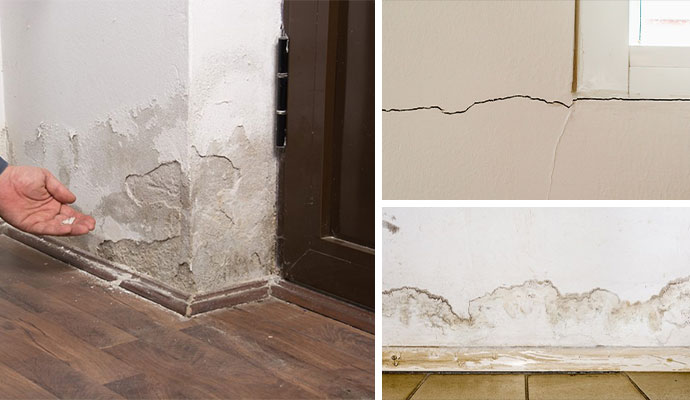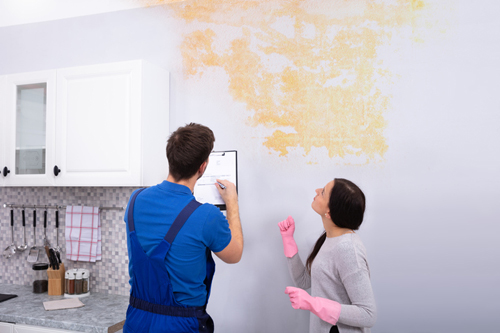Identify and Repair Stains from Water Expertly
Book A ServiceWhat are your thoughts with regards to Water Stains on Walls?

Water discolorations on walls are not pleasant to the eyes. Your home ought to lack stains on the walls, roofing system, or floorings. That is the excellent state of a house and also its frameworks. Sometimes it appears virtually inevitable to experience water stains on wall surfaces in residences.
House owners living in damp regions regularly deal with the worry of water discolorations on wall surfaces. With exact and well-shaped info on the reasons of water discolorations and prompt fixing procedures, you will always be an action in advance of such occurrences.
3 Usual Root Causes Of Water Discolorations on Walls
In contrast to common belief, water stains on wall surfaces do not constantly originate from inadequate structure materials. There are several sources of water discolorations on walls. These consist of:
Poor Water drainage
This will certainly stop water from permeating into the wall surfaces. This links to extreme wetness that you observe on the wall surfaces of your building.
So, the leading reason for wet walls, in this case, can be an inadequate drain system. It can likewise be because of bad administration of sewage pipelines that go through the building.
Wet
When hot wet air consults with completely dry cold air, it creates water droplets to form on the wall surfaces of buildings. This happens in kitchens and bathrooms when there is vapor from cooking or showers. The water beads can tarnish the surrounding walls in these parts of your house and also spread to other areas.
Moist or condensation influences the roofing and also walls of buildings. When the wall is damp, it develops an ideal environment for the development of microbes and also fungis.
Pipeline Leaks
A lot of homes have a network of water pipes within the wall surfaces. This guarantees that the pipelines are well away from the reach of devastating rats. It always raises the feasibility of such pipes, as there is little oxygen within the walls. This prevents corrosion.
A downside to this is that water leak affects the walls of the building and also causes widespread damages. An indicator of faulty pipes is the look of a water stain on the wall.
Water Spots on Wall Surface: Repair Service Tips
When dealing with water stains, homeowners would generally desire a fast repair. They would certainly quickly understand this is disadvantageous as the water spots recur. Right here are a few helpful pointers that will certainly direct you in the repair service of water stains on walls:
Pro Idea
A houseplant in your home additionally raises its humidity. If the residence is already humid, you may desire to introduce houseplants with marginal transpiration. An example of suitable houseplants is succulents.
Final thought
No one desires to have water discolorations on walls in their home, it can occur to the finest of us. This short article provides you take advantage of, as you currently understand how to handle this accident if it does take place.
It is constantly best to recruit expert solutions to help deal with the problems in your home.
Often it appears nearly inevitable to experience water stains on wall surfaces in homes.
Contrary to popular belief, water spots on wall surfaces do not constantly stem from inadequate building materials. There are a number of reasons of water discolorations on wall surfaces. The water beads can stain the bordering walls in these parts of your home as well as spread to other areas.
Here are a couple of useful suggestions that will lead you in the repair service of water spots on walls:
CHECKING FOR WATER DAMAGE
Water damage can be costly, and it may begin before you even notice the first signs of trouble. Water damage can cause mold and mildew in your walls and floors, which can create an abundance of health concerns for your family. It can also lead to costly repairs of various appliances and general home fixtures. To avoid the pricey consequences of water damage, here are Warner Service’s top 5 places you should check:
The walls – The easiest place to spot the beginnings of water damage is on the walls and ceilings of your home. If water damage is present, there will most likely be water stains, especially around the windows and doorframes, and/or cracks in the drywall. If a stain looks unusual (discolored to brown, black or gray, raised texture), has a swollen appearance or is soft to the touch, contact a professional immediately. The pipes – To avoid water damage, consistently check the pipes in your kitchen (especially the dishwasher and ice maker), bathrooms, laundry room (specifically washing machines) and basement for corrosion, leaks and water stains. Pay special attention to where the pipes connect in your home and the location of caulking around the bathroom fixtures, including toilets, sinks, showers and tubs. Missing or loose caulking and grout could be signs of leaking water. This seepage can also quickly cause mold and rust, so double check your water heater and tank for wet spots on the floor. The floor – Water damage is very easy to spot on the floor. Look for any warping or buckling of the material, especially in the basement. If your home has wood flooring, look for bright white or dark stains. If your home has carpeting, keep it dry and clean. A damp carpet that smells of mold could cause water damage and health problems. To avoid this, consider installing floor pans under your appliances to help prevent damages from small, slow and undetected leaks. The basement and attic – If your basement or attic smells odd check for mold and mildew around the area, especially the valley where the roof meets. While you are inspecting those areas, check for wall cracks, floor stains, rust and dampness in the insulation. If you live in a colder and/or rainier climate, perform routine checks for water damage from melting snow or ice and rain. The exterior – Check the roof for damaged flashing and missing, cracked or curled shingles. There should also be no standing water anywhere outside your home. This could be caused by puddles, leaky rain gutters or hoses, poor drainage, or short gutter spouts. Invest in a sump pump system or water flow monitoring system, and perform routine maintenance on these outdoor appliances to avoid indoor water damage.

We hope you liked our excerpt about How to Remove Water Stains from Walls and Ceilings. Thanks for taking a few minutes to read through our article. You should take the time to share this write-up if you enjoyed it. Thanks for your time. Kindly come by our blog back soon.
Tap issues? Ring!